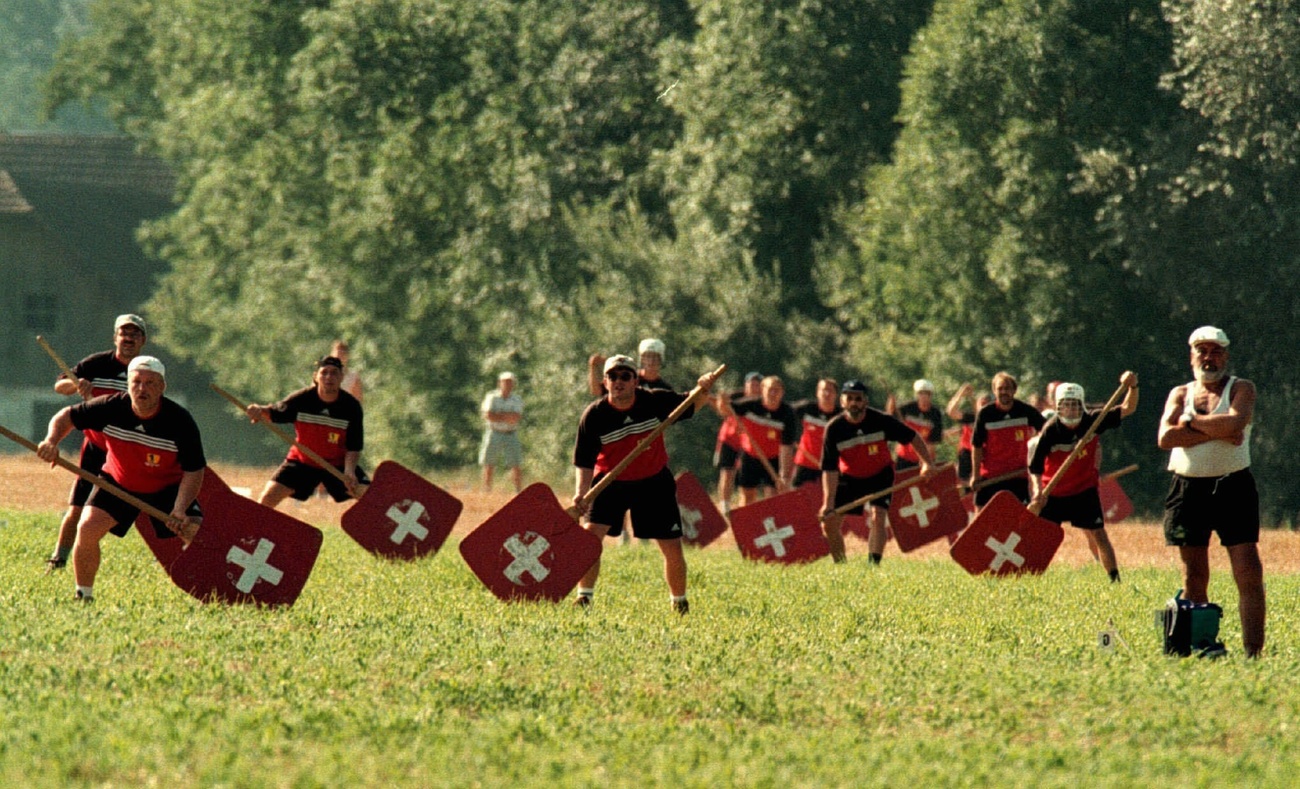
Ups and downs: a first taste of competitive Swiss flag throwing

Fahnenschwingen, flag throwing, is one of the living traditions of Switzerland, together with Swiss wrestling, yodelling and alphorn playing. We met Alexander, a 15-year-old boy from the Emmental valley, who loves tinkering with engines and is passionate about the art of flag throwing.
Alexander has withdrawn to a corner with his father. He is visibly nervous. He movements are jerky, his gaze is fixed on the ceiling. It will soon be his turn to perform. At last, the master of ceremonies calls him forward, putting an end to his anxious wait.
It is 5:36pm. Alexander slings the flagpole over his shoulder and strides over to the performance area: a blue carpet with two concentric circles in the middle. His face betrays none of his inner turmoil. He grips the flagpole with his right hand, his left hand resting on his hip. The sound of yodelling can be heard in the background. Behind him hangs a large painting of a bucolic mountain landscape.
After a last glance at the position of his feet, which are perfectly centred in the smaller circle, Alexander begins his presentation. The first moves are easy and he executes them perfectly. The flag flutters in the air and passes from one hand to the other. But then, during a throw, something goes wrong: the flag slips from his grasp and falls to the ground. This lasts just a few seconds, which seem an eternity. Without batting an eyelid, the boy picks up the flag and starts waving it again.
He has three minutes to perform 12 different movementsExternal link, using his left and right hands alternately: Beinwelle, hoher Überschlag, Kopfwelle, Beinumschwung, offener Überwurf and so on. When the head judge utters the word “good!”, it means his allotted time is over. For a few seconds, Alexander stands still, the flag hanging horizontally beside him. He then puts it on his right shoulder and walks off the stage. The audience applauds and he gives a faint smile. Family and friends greet him with handshakes and pats on the back. “It could have been worse,” he says.
Duration and procedure
• Each performance lasts three minutes and is carried out individually or in pairs.
• The performance begins and ends when the head judge utters the word “good”.
• All moves must be carried out with both the right and left hand.
Place and moves
• The flag thrower moves around within a circle. The inner circle is 60cm in diameter and the outer circle 150cm in diameter.
• The performers must not move out of the circle, raise their heels or take steps forward (otherwise they get a penalty).
• The flag must not touch the body or the ground, and must remain open and in motion at all times.
• The hand not being used must be held in a resting position on the hip.
• At least two Hochschwünge (high tosses), chosen from the 49 set movementsExternal link, must be shown.
Flag specifications
• Standard flag size: 120cm x 120cm.
• Flag size for children: 80cm x 80cm or 100cm x 100cm.
• It must be a cantonal or Swiss flag.
Judges and evaluation
• The jury consists of three members, including a head judge or Obmann.
• The judges observe various aspects: movement technique and precision, position in the circle, steps, balance, correct execution of the throws and use of both hands, difficulty of the exercise, height of the throws and technical mastery.
• At the end, a score between 0 and 30 is awarded.
First time competing
We are in the village of St Stephan, a few kilometres from the better-known tourist resort of Lenk, in the Obersimmental district, during the 2025 Bernese Cantonal Yodelling FestivalExternal link. This event brings together yodellers, alphorn players and flag throwers from all over Switzerland.
It is Alexander’s first-ever competition. He has attended countless similar festivals in the past, together with his mother Heidi, his father Manuel and his sister Nicole, but always as a spectator. “I started practising for this a year ago,” he explains during the trip to St Stephan. Many long hours were spent learning the different moves, holds and routines.

During the competition, each participant can perform alone or in pairs in front of a three-member jury. Flag throwers wear traditional dress and must present a sequence of figures. The judges assess precision, variety, speed, position, fluidity of movement and technical mastery. Particular attention is paid to their ability to toss the flag high in the air and catch it again.
“Above all, you need concentration, coordination and good balance,” says Manuel, Alexander’s father. “We’re a close-knit family and being together is more important than the result.”
Recent research refutes the theory, still widespread in Switzerland, that flag throwing originated when Swiss soldiers served as mercenaries for foreign European powers. Historical documents reveal that, even before the return of the mercenaries (between the 16th and 18th centuries), herdsmen in canton Uri practised flag throwing, using short-handled flags made of heavy silk.
With the development of tourism in the 19th and 20th centuries, Swiss folk traditions received new impetus. In 1910, Oskar Friedrich Schmalz founded the Swiss Yodelling Association in Bern, which since 1922 has included the Alpine flag throwers of central Switzerland, alongside yodellers and alphorn players.
(Source: Fahnenschwinger-Vereinigung der NordwestscheizExternal link)
Alexander’s world
Alexander and his family live in Heimisbach, in the heart of the Emmental. Their farmhouse is perched on the top of a hill with a stunning view.
“I’m not interested in football or hockey,” he says. “But I love flag throwing, even though my classmates think it’s a waste of time. For me, it symbolises tradition and home.”

More
Heimatort, sweet Heimatort: the unique Swiss concept of home
He goes to practise at the the village sports hall every Friday evening, together with his father, who has followed this passion for over 30 years. There he meets his friend Yannick and other – adult – flag throwers.
“The individual moves are relatively easy to do. The real challenge is being able to combine them harmoniously, using both the right and left hand.”

More
Hornussen, the Swiss national sport with a sting
Alexander’s world is centred on engines, books and his three pygmy goats. In one year he will finish compulsory schooling and enter the world of work.
“I want to become an agricultural machinery mechanic,” he says. After school and during the summer holidays he helps his family with the cows or with haymaking. But he does this more out of a sense of duty than passion.
What he really loves is engrossing himself in a book, looking after his goats and tinkering around with his moped, which he uses to get to school or roam the hills around Sumiswald.
“I’d like to soup it up, but my parents won’t let me,” he says, adding that he doesn’t know a lot about engines yet, but that he will learn more during his apprenticeship. For now, he limits himself to greasing his father’s vintage farm vehicles, made by Swiss manufacturer Schilter.

Back in St Stephan, the performance is over and Alexander can finally enjoy the family outing. He feels at home at the yodelling festival, surrounded by flag throwers, yodellers and alphorn players, all in traditional dress. Sitting on a woodpile, mobile phone in hand, he spends a few minutes lost in the internet. Then he slips the phone back into his trouser pocket and returns to the festival, his Swiss flag rolled up at his side and the sound of yodelling in the background.
Edited by Daniele Mariani. Adapted from Italian by Julia Bassam/ts
More

In compliance with the JTI standards
More: SWI swissinfo.ch certified by the Journalism Trust Initiative
















































You can find an overview of ongoing debates with our journalists here . Please join us!
If you want to start a conversation about a topic raised in this article or want to report factual errors, email us at english@swissinfo.ch.